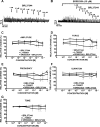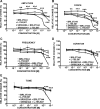Do β3-adrenergic receptors play a role in guinea pig detrusor smooth muscle excitability and contractility?
- PMID: 21993887
- PMCID: PMC3340921
- DOI: 10.1152/ajprenal.00378.2011
Do β3-adrenergic receptors play a role in guinea pig detrusor smooth muscle excitability and contractility?
Abstract
In many species, β3-adrenergic receptors (β3-ARs) have been reported to play a primary role in pharmacologically induced detrusor smooth muscle (DSM) relaxation. However, their role in guinea pig DSM remains controversial. The aim of this study was to investigate whether β3-ARs are expressed in guinea pig DSM and to evaluate how BRL37344 and L-755,507, two selective β3-AR agonists, modulate guinea pig DSM excitability and contractility. We used a combined experimental approach including RT-PCR, patch-clamp electrophysiology, and isometric DSM tension recordings. β3-AR mRNA message was detected in freshly isolated guinea pig DSM single cells. BRL37344 but not L-755,507 caused a slight decrease in DSM spontaneous phasic contraction amplitude and frequency in a concentration-dependent manner. In the presence of atropine (1 μM), only the spontaneous phasic contractions frequency was inhibited by BRL37344 at higher concentrations. Both BRL37344 and L-755,507 significantly decreased DSM carbachol-induced phasic and tonic contractions in a concentration-dependent manner. However, only BRL37344 inhibitory effect was partially antagonized by SR59230A (10 μM), a β3-AR antagonist. In the presence of atropine, BRL37344 and L-755,507 had no inhibitory effect on electrical field stimulation-induced contractions. Patch-clamp experiments showed that BRL37344 (100 μM) did not affect the DSM cell resting membrane potential and K(+) conductance. Although β3-ARs are expressed at the mRNA level, they play a minor to no role in guinea pig DSM spontaneous contractility without affecting cell excitability. However, BRL37344 and L-755,507 have pronounced inhibitory effects on guinea pig DSM carbachol-induced contractions. The study outlines important DSM β3-ARs species differences.
Figures










References
-
- Andersson KE. Pharmacotherapy of the overactive bladder. Discov Med 8: 118–124, 2009 - PubMed
-
- Andersson KE, Arner A. Urinary bladder contraction and relaxation: physiology and pathophysiology. Physiol Rev 84: 935–986, 2004 - PubMed
-
- Biers SM, Reynard JM, Brading AF. The effects of a new selective beta3-adrenoceptor agonist (GW427353) on spontaneous activity and detrusor relaxation in human bladder. BJU Int 98: 1310–1314, 2006 - PubMed
-
- Biers SM, Reynard JM, Doore T, Brading AF. The functional effects of a c-kit tyrosine inhibitor on guinea-pig and human detrusor. BJU Int 97: 612–616, 2006 - PubMed
-
- Brown SM, Bentcheva-Petkova LM, Liu L, Hristov KL, Chen M, Kellett WF, Meredith AL, Aldrich RW, Nelson MT, Petkov GV. β-Adrenergic relaxation of mouse urinary bladder smooth muscle in the absence of large-conductance Ca2+-activated K+ channel. Am J Physiol Renal Physiol 295: F1149–F1157, 2008 - PMC - PubMed
Publication types
MeSH terms
Substances
Grants and funding
LinkOut - more resources
Full Text Sources
Research Materials

